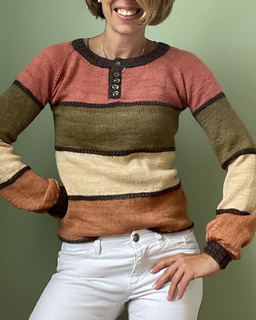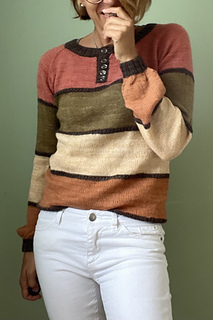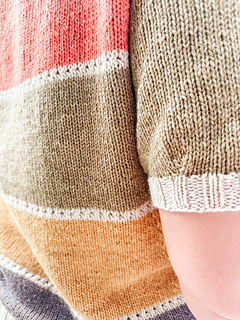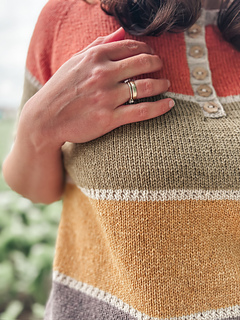patterns >  Carolin Balmes' Ravelry Store
Carolin Balmes' Ravelry Store
> Hedis Blouse







Hedis Blouse
Hedi’s blouse stands out with its harmonious color block stripes – a true eye-catcher for the transitional season and sunny days. The relaxed fit with raglan sleeves and half bands gives the top a casual yet stylish touch. The alternating colors create clean lines that make the design feel both modern and timeless. The pattern also offers the option to choose between short or long sleeves – allowing you to customize the blouse to suit any season and personal style.
Hedi’s Blouse is knitted top-down with raglan increases. You start at the neckline and first shape the back of the neck using short rows. You work raglan increases for the sleeves and body back and forth in rows. Once the yoke is complete, the piece is joined in the round after working the neckband edges. At the same time, the sleeve stitches are put on hold. The body and sleeves are then completed one after the other.
Finally, you pick up stitches from the cast-on edge and knit the neckband.
Sizes
1 (2, 3) 4 5, 6 with a bust circumference on the finished garment of 84,5/33.3 (91/35.8, 98/38.6) 106,5/41.9 115/45.3, 125/49.2
I recommend a positive ease of approx. 2-8 cm/ 0.8 – 3.1 in.
Yarn
In total, you will need approximately:
For the short-sleeved version:
670 (760, 860) 970 1090, 1250 m / 733 (832, 941) 1061 1192, 1367 yds
For the long-sleeved version:
850 (960, 1080) 1190 1310, 1460 m / 930 (1050, 1180) 1302 1434, 1597 yds “fingering-weight” yarn (365–525 m = 100 g), for example:
- ‚Bio Balance‘ by BC Garn (225 m = 50 g)
If you want to color the blouse like the example, using five different colors, you will need approximately:
For the short-sleeved version:
130 (140, 150) 180 200, 250 m / 142 (153, 164) 197 219, 273 yds of the top color,
190 (220, 250) 270 310, 350 m / 208 (241, 273) 295 339, 383 yds of the second color,
120 (140, 160) 180 200, 220 m / 131 (153, 175) 197 219, 240 yds per color on the body, and
110 (120, 140) 160 180, 210 m / 120 (131, 153) 175 197, 229 yds of the contrast color for ribbings and pattern stripes.
For the long-sleeved version:
130 (140, 150) 180 200, 250 m / 142 (153, 164) 197 219, 273 yds of the top color,
190 (220, 250) 270 300, 330 m / 208 (241, 273) 295 328, 361 yds of the second, third, and fourth colors, and
150 (160, 180) 200 210, 220 m / 164 (175, 197) 219 230, 240 yds of the contrast color for ribbings and pattern stripes.
Note: The yarn amounts refer to the given measurements and are calculated generously. If you knit the top longer or shorter, keep in mind that you may need more or less yarn.
Gauge
10 x 10 cm / 4 x 4 in= 23 sts x 35 rows in stockinette stitch with the larger needle.
Wash and let the swatch dry, before measuring it.
Other materials
- 3,0 and 3,5 mm / US2.5 and US4 circular needle or the needle size you need to achieve the specified gauge, possibly double-pointed needles in the same size for the armholes if you are not using the Magic Loop method
- stitchmarker
- Buttons in the quantity you choose (see the section “Band for Buttons”), approximately 1–1.5 cm / 0.39 – 0.59 in in diameter.
- Scrap yarn for place stitches on hold
- Tapestry needle for weaving in the ends
………………………………………………………………………………….
Hedis Blouse besticht durch ihre harmonischen Blockstreifen – ein echter Hingucker für die Übergangszeit und sonnige Tage. Der legere Schnitt mit Raglanärmeln und halber Knopfleiste verleiht dem Oberteil eine entspannte, dennoch stilvolle Note. Durch den Wechsel der Farben entstehen klare Linien, die das Design modern und zeitlos zugleich wirken lassen. Die Anleitung bietet zudem die Möglichkeit, zwischen kurzen oder langen Ärmeln zu wählen – so lässt sich die Bluse individuell an jede Jahreszeit und jeden Stil anpassen.
Hedis Blouse wird von oben nach unten mit Raglanzunahmen gestrickt. Du beginnst am Halsausschnitt und formst zunächst den Nacken mit Hilfe von verkürzten Reihen. Du strickst Raglanzunahmen für Ärmel und Rumpf in Reihen. Sobald die Passe fertig ist, wird das Strickstück nach dem Arbeiten der Blenden am Ausschnitt zur Runde geschlossen. Gleichzeitig werden die Ärmelmaschen stillgelegt.
Körper und Ärmel werden nun nacheinander beendet. Abschließend nimmst du Maschen aus der Anschlagskante auf und strickst das Halsbündchen.
Größen
1 (2, 3) 4 5, 6 mit einem Brustumfang des fertigen Shirts/Pullovers von 84,5 (91, 98) 106,5 115, 125 cm
Ich empfehle einen Bewegungsspielraum von
ungefähr 2 - 8 cm.
Garn
Insgesamt benötigst du ungefähr:
Für die kurzärmelige Version:
670 (760, 860) 970 1090, 1250 m
Für die langärmelige Version:
850 (960, 1080) 1190 1310, 1460 m „Fingering-weight“ Garn (365-525 m = 100g), z.B.
- ‚Bio Balance‘ von BC Garn (225 m = 50 g)
Möchtest du die Bluse farblich so gestalten wie im Beispiel, also mit fünf unterschiedlichen Farben, benötigst du ungefähr:
Für die kurzärmelige Version:
130 (140, 150) 180 200, 250 m der obersten Farbe,
190 (220, 250) 270 310, 350 m der zweiten Farbe,
120 (140, 160) 180 200, 220 m pro Farbe am Körper und
110 (120, 140) 160 180, 210 m der Kontrastfarbe für Bündchen und Musterstreifen.
Für die langärmelige Version:
130 (140, 150) 180 200, 250 m der obersten Farbe,
190 (220, 250) 270 300, 330 m der zweiten, dritten und vierten Farbe, und 150 (160, 180) 200 210, 220 m der Kontrastfarbe für Bündchen und Musterstreifen.
Achtung: Der Verbrauch bezieht sich auf die angegebenen Maße und ist großzügig kalkuliert. Strickst du das Top länger oder kürzer, bedenke, dass du ggf. mehr oder weniger Garn benötigst.
Maschenprobe
10 x 10 cm = 23 M x 35 R mit der größeren Nadel glatt rechts gestrickt.
Sonstige Materialien
- 3,0 und 3,5 mm Rundstricknadel bzw. die Nadelgröße, die du benötigst, um die angegebene Maschenprobe zu erreichen; ggf. ein Nadelspiel in der gleichen Größe für die Ärmel, wenn du nicht die Magic-Loop-Methode verwendest
- Maschenmarkierer
- Knöpfe in der von dir gewählten Anzahl (siehe Abschnitt „Knopfblende“) mit ca. 1-1,5 cm Durchmesser
- Nadelhalter oder Garnreste zum Stilllegen von Maschen
- Wollnadel zum Fäden vernähen
7485 projects
stashed
5557 times
- First published: August 2025
- Page created: August 7, 2025
- Last updated: August 7, 2025 …
- visits in the last 24 hours
- visitors right now




